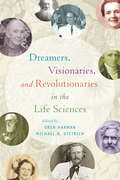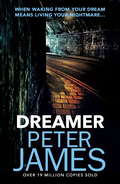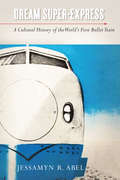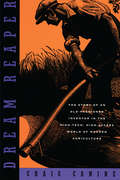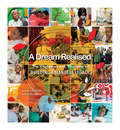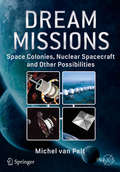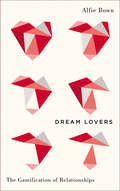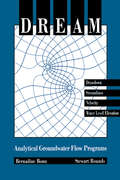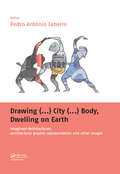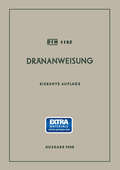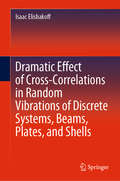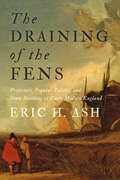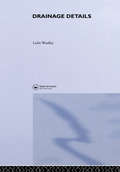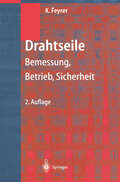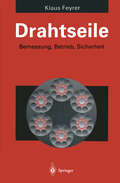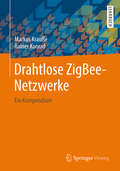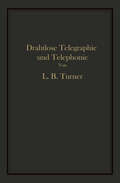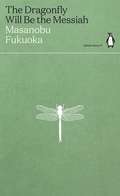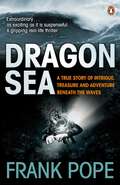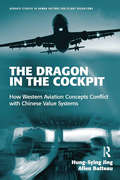- Table View
- List View
Dreamers, Visionaries, and Revolutionaries in the Life Sciences
by Oren Harman Michael R. Dietrich Michael DietrichWhat are the conditions that foster true novelty and allow visionaries to set their eyes on unknown horizons? What have been the challenges that have spawned new innovations, and how have they shaped modern biology? In Dreamers, Visionaries, and Revolutionaries in the Life Sciences, editors Oren Harman and Michael R. Dietrich explore these questions through the lives of eighteen exemplary biologists who had grand and often radical ideas that went far beyond the run-of-the-mill science of their peers. From the Frenchman Jean-Baptiste Lamarck, who coined the word “biology” in the early nineteenth century, to the American James Lovelock, for whom the Earth is a living, breathing organism, these dreamers innovated in ways that forced their contemporaries to reexamine comfortable truths. With this collection readers will follow Jane Goodall into the hidden world of apes in African jungles and Francis Crick as he attacks the problem of consciousness. Join Mary Lasker on her campaign to conquer cancer and follow geneticist George Church as he dreams of bringing back woolly mammoths and Neanderthals. In these lives and the many others featured in these pages, we discover visions that were sometimes fantastical, quixotic, and even threatening and destabilizing, but always a challenge to the status quo.
Dreamers, Visionaries, and Revolutionaries in the Life Sciences
What are the conditions that foster true novelty and allow visionaries to set their eyes on unknown horizons? What have been the challenges that have spawned new innovations, and how have they shaped modern biology? In Dreamers, Visionaries, and Revolutionaries in the Life Sciences, editors Oren Harman and Michael R. Dietrich explore these questions through the lives of eighteen exemplary biologists who had grand and often radical ideas that went far beyond the run-of-the-mill science of their peers. From the Frenchman Jean-Baptiste Lamarck, who coined the word “biology” in the early nineteenth century, to the American James Lovelock, for whom the Earth is a living, breathing organism, these dreamers innovated in ways that forced their contemporaries to reexamine comfortable truths. With this collection readers will follow Jane Goodall into the hidden world of apes in African jungles and Francis Crick as he attacks the problem of consciousness. Join Mary Lasker on her campaign to conquer cancer and follow geneticist George Church as he dreams of bringing back woolly mammoths and Neanderthals. In these lives and the many others featured in these pages, we discover visions that were sometimes fantastical, quixotic, and even threatening and destabilizing, but always a challenge to the status quo.
Dreamer: An Autobiography
by Peter JamesWhen waking from your dream means living your nightmare...The last time the dream came, Sam was seven years old; and that was the night her parents were to die.Twenty-five years later, Sam's nightmares are starting to come true once more. Now a successful TV commercials producer, juggling her roles of career woman, wife and mother, she attempts to shut them out.But soon Sam is faced with the reality of dreams in which her life and that of her family are threatened. In desperation, she consults the experts: a psychiatrist; a clairvoyant ... but to no avail. Sam is being inexorably drawn into a vortex of terror from which there is no escape...'Britain's closest equivalent to Stephen King.' Sunday Times 'Peter James is getting better with every book.' TimesRead more from the multi-million copy bestselling author of the Roy Grace novels:Possession DreamerSweet Heart Twilight Prophecy Host Alchemist Denial The Truth Faith * Each Peter James novel can be read as a standalone*
Dream Super-Express: A Cultural History of the World's First Bullet Train (Studies of the Weatherhead East Asian Institute, Columbia University)
by Jessamyn AbelA symbol of the "new Japan" displayed at World's Fairs, depicted in travel posters, and celebrated as the product of a national spirit of innovation, the Tōkaidō Shinkansen—the first bullet train, dubbed the "dream super-express"—represents the bold aspirations of a nation rebranding itself after military defeat, but also the deep problems caused by the unbridled postwar drive for economic growth. At the dawn of the space age, how could a train become such an important symbol? In Dream Super-Express, Jessamyn Abel contends that understanding the various, often contradictory, images of the bullet train reveals how infrastructure operates beyond its intended use as a means of transportation to perform cultural and sociological functions. The multi-layered dreams surrounding this high-speed railway tell a history not only of nation-building but of resistance and disruption. Though it constituted neither a major technological leap nor a new infrastructural connection, the train enchanted, enthralled, and enraged government officials, media pundits, community activists, novelists, and filmmakers. This history of imaginations around the monumental rail system resists the commonplace story of progress to consider the tug-of-war over the significance of the new line. Is it a vision of the future or a reminder of the past, an object of international admiration or a formidable threat? Does it enable new relationships and identities or reify existing social hierarchies? Tracing the meanings assigned to high-speed rail shows how it prompted a reimagination of identity on the levels of individual, metropolis, and nation in a changing Japan.
Dream Reaper: The Story of an Old-Fashioned Inventor in the High-Tech, High-Stakes World of Modern Agriculture
by Craig CanineDream Reaper follows Mark Underwood, farmer and inventor, and his salesman cousin as they strive to perfect and market Mark's breakthrough invention, the Bi-Rotor combine. "This intriguing tale weaves together the creativity and ingenuity of an inventor and the hurdles he and his partner face in selling and producing what appears to be an amazingly efficient Bi-Rotor combine."—Science News "Canine writes with style and flourish. . . Dream Reaper is a riveting journey into America's heartland, where necessity is the mother of invention—and hard work, conviction, and sacrifice are its lifeblood."—People Magazine "Canine deftly interweaves the story of the two men's struggles with a history of the mechanization of agriculture. This lively account of men working under pressure, improvising repairs and demonstrating the new machine, is also a story of courage that illustrates the barriers facing an independent inventor."—Publishers Weekly "Craig Canine's Dream Reaper is a delight. It's an important book, rich with history and stories. It brings our most essential industry—farming—into new perspective. Reading it made me want to get out a crop."—Bobbie Ann Mason A volume in the Sloan Technology Series. The series presents to a general audience highly readable accounts of the development of 20th century technologies and the ways these have shaped and are shaped by society.
A Dream Realised: The Challenges and Triumphs of Building a Mandela Legacy
by Ulrike Hill Zanele Chakela‘How can there be only one dedicated hospital in the country for our children?’ When Madiba asked this question, he sowed the seeds of a challenge that would grow into a legacy.A seed may be small but its size is disproportionate to what it can become over time. The Nelson Mandela Children’s Hospital was a project that seemed impossible when it was just an idea that started with ten people seated around a dinner table. As they discussed the state of healthcare in the country and shared their experiences, they realised that it was the children of Southern Africa who were the most disadvantaged by the lack of dedicated paediatric facilities. At the end of the evening a statement by the late Dr Nthato Motlana took hold and became the catalyst for a remarkable journey: ‘I will speak to Nelson,’ he said.With South Africa’s first democratically elected president Nelson Mandela’s backing, the board of the Children’s Fund was inspired to take up the challenge to address this vital need. After years of global research and advice from experts in numerous different fields a Trust was formed to oversee the project and, critically, to set about raising the one billion rand it would take to build, equip and staff a state-of-the-art children’s hospital.The stories behind the planning for, fundraising and building of the Nelson Mandela Children’s Hospital are inspiring, personal, and sometimes heart-breaking. It was a long and arduous journey, beset with difficulties, but the dedicated team’s commitment and courage prevailed to create a living legacy that will truly impact the lives of children for generations to come.Today, the Nelson Mandela Children’s Hospital in Johannesburg is a proud testimony to a uniquely African story which honours the memory of a great statesman and celebrates the children for whom he cared so deeply.
Dream Missions: Space Colonies, Nuclear Spacecraft and Other Possibilities (Springer Praxis Books)
by Michel Van PeltThis book takes the reader on a journey through the history of extremely ambitious, large and complex space missions that never happened. What were the dreams and expectations of the visionaries behind these plans, and why were they not successful in bringing their projects to reality thus far? As spaceflight development progressed, new technologies and ideas led to pushing the boundaries of engineering and technology though still grounded in real scientific possibilities. Examples are space colonies, nuclear-propelled interplanetary spacecraft, space telescopes consisting of multiple satellites and canon launch systems. Each project described in this book says something about the dreams and expectations of their time, and their demise was often linked to an important change in the cultural, political and social state of the world.For each mission or spacecraft concept, the following will be covered:• Description of the design.• Overview of the history of the concept and the people involved.• Why it was never developed and flown• What if the mission was actually carried out – consequences, further developments, etc.
Dream Lovers: The Gamification of Relationships (Digital Barricades)
by Alfie BownWe are in the middle of a 'desirevolution' - a fundamental and political transformation of the way we desire as human beings. Perhaps as always, new technologies - with their associated and inherited political biases - are organising and mapping the future. What we don’t seem to notice is that the primary way in which our lives are being transformed is through the manipulation and control of desire itself. Our very impulses, drives and urges are 'gamified' to suit particular economic and political agendas, changing the way we relate to everything from lovers and friends to food and politicians. Digital technologies are transforming the subject at the deepest level of desire – re-mapping its libidinal economy - in ways never before imagined possible. From sexbots to smart condoms, fitbits to VR simulators and AI to dating algorithms, the 'love industries' are at the heart of the future smart city and the social fabric of everyday life. This book considers these emergent technologies and what they mean for the future of love, desire, work and capitalism.
Dream-Analytical Ground Water Flow Programs
by Stewart Rounds Bernadine A. BonnValuable for consultants and regulators...Dream is a useful tool for basic field work, including the first-cut evaluation of remediation design. Ground water professionals will find Dream to be ideal for estimating actual flow conditions when information on aquifer properties is limited. Flow nets, streamline plots, and capture zone maps are easily produced by contouring Dream's output files. Maps of head, drawdown, and ground water velocity are equally simple to create. These provide an uncomplicated method for estimating both direction and magnitude of flow, and the areal extent of the well's influence. This must-have volume is valuable for hydrologists, regulators, ground water professionals, students, professors, and consultants. This work is a valuable teaching tool for principles of subsurface hydrology. It is easy-to-use and illustrates hydrologic concepts, pumping schemes, remediation schemes, etc. The importance of fundamental aquifer properties can be easily explored, at both the graduate and undergraduate levels.
Dream-Analytical Ground Water Flow Programs
by Stewart Rounds Bernadine A. BonnValuable for consultants and regulators...Dream is a useful tool for basic field work, including the first-cut evaluation of remediation design. Ground water professionals will find Dream to be ideal for estimating actual flow conditions when information on aquifer properties is limited. Flow nets, streamline plots, and capture zone maps are easily produced by contouring Dream's output files. Maps of head, drawdown, and ground water velocity are equally simple to create. These provide an uncomplicated method for estimating both direction and magnitude of flow, and the areal extent of the well's influence. This must-have volume is valuable for hydrologists, regulators, ground water professionals, students, professors, and consultants. This work is a valuable teaching tool for principles of subsurface hydrology. It is easy-to-use and illustrates hydrologic concepts, pumping schemes, remediation schemes, etc. The importance of fundamental aquifer properties can be easily explored, at both the graduate and undergraduate levels.
Drawing (...) City (...) Body, Dwelling on Earth: Imagined-Architectures: Architectural Graphic Representation and Other Images
by Pedro António JaneiroThis international seminar’s fifth edition, dedicated to the theme Desenho (...) Cidade (…) Corpo, Habitando a Terra (Drawing […] City […] Body, Inhabiting the Earth) was held as a joint activity between: this C.I.A.U.D./F.A./U.Lisboa Research Project, the University of São Paulo, represented by the Maria Antônia University Centre, and the Faculty of Architecture and Urbanism of the Federal University of Juiz de Fora. Its objectives were threefold: To discuss how Drawing in/of the City and the elements that identify it (geographical area, inhabitants, natural landscape and/or built landscape; present, desired or memorable facts and data) are represented and identified through the presence and/or action of the body, in the form of gestures, movements, interventions, displacements or permanence. To problematise the association between Drawing and City from the starting point of the perception of the Body, assuming this mediation as a condition for the particular construction of that relationship. To identify the presence of the Body in the Representations/Drawings of the City, submitting this event or phenomenon to analysis, aiming for cognitive production. The contributions will be of interest to artists, academics and professionals in the fields of drawing and the arts, architecture, sociology, philosophy, urbanism and design.
Dramatic Effect of Cross-Correlations in Random Vibrations of Discrete Systems, Beams, Plates, and Shells
by Isaac ElishakoffThis volume explains the dramatic effect of cross-correlations in forming the structural response of aircraft in turbulent excitation, ships in rough seas, cars on irregular roads, and other dynamic regimes. It brings into sharp focus the dramatic effect of cross correlations often neglected due to the analytical difficulty of their evaluation. Veteran author Professor Isaac Elishakoff illustrates how neglect of cross correlations could result in underestimation of the response by tens or hundreds of percentages the effect of the random vibrations of structures’ main elements, including beams, plates, and shells.
The Draining of the Fens: Projectors, Popular Politics, and State Building in Early Modern England (Johns Hopkins Studies in the History of Technology)
by Eric H. AshThe draining of the Fens in eastern England was one of the largest engineering projects in seventeenth-century Europe. A series of Dutch and English "projectors," working over several decades and with the full support of the Crown, transformed hundreds of thousands of acres of putatively barren wetlands into dry, arable farmland. The drainage project was also supposed to reform the sickly, backward fenlanders into civilized, healthy farmers, to the benefit of the entire commonwealth. As projectors reconstructed entire river systems, these new, artificial channels profoundly altered both the landscape and the lives of those who lived on it. In this definitive account, historian Eric H. Ash provides a detailed history of this ambitious undertaking. Ash traces the endeavor from the 1570s, when draining the whole of the Fens became an imaginable goal for the Crown, through several failed efforts in the early 1600s. The book closes in the 1650s, when, in spite of the project's enormous difficulty and expense, the draining of the Great Level of the Fens was finally completed. Ash ultimately concludes that the transformation of the Fens into fertile farmland had unintended ecological consequences that created at least as many problems as it solved.Drawing on painstaking archival research, Ash explores the drainage from the perspectives of political, social, and environmental history. He argues that the efficient management and exploitation of fenland natural resources in the rising nation-state of early modern England was a crucial problem for the Crown, one that provoked violent confrontations with fenland inhabitants, who viewed the drainage (and accompanying land seizure) as a grave threat to their local landscape, economy, and way of life. The drainage also reveals much about the political flashpoints that roiled England during the mid;€“seventeenth century leading up to the violence of the English Civil War. This is compelling reading for British historians, environmental scholars, historians of technology, and anyone interested in state formation in early modern Europe.
The Draining of the Fens: Projectors, Popular Politics, and State Building in Early Modern England (Johns Hopkins Studies in the History of Technology)
by Eric H. AshThe draining of the Fens in eastern England was one of the largest engineering projects in seventeenth-century Europe. A series of Dutch and English "projectors," working over several decades and with the full support of the Crown, transformed hundreds of thousands of acres of putatively barren wetlands into dry, arable farmland. The drainage project was also supposed to reform the sickly, backward fenlanders into civilized, healthy farmers, to the benefit of the entire commonwealth. As projectors reconstructed entire river systems, these new, artificial channels profoundly altered both the landscape and the lives of those who lived on it. In this definitive account, historian Eric H. Ash provides a detailed history of this ambitious undertaking. Ash traces the endeavor from the 1570s, when draining the whole of the Fens became an imaginable goal for the Crown, through several failed efforts in the early 1600s. The book closes in the 1650s, when, in spite of the project's enormous difficulty and expense, the draining of the Great Level of the Fens was finally completed. Ash ultimately concludes that the transformation of the Fens into fertile farmland had unintended ecological consequences that created at least as many problems as it solved.Drawing on painstaking archival research, Ash explores the drainage from the perspectives of political, social, and environmental history. He argues that the efficient management and exploitation of fenland natural resources in the rising nation-state of early modern England was a crucial problem for the Crown, one that provoked violent confrontations with fenland inhabitants, who viewed the drainage (and accompanying land seizure) as a grave threat to their local landscape, economy, and way of life. The drainage also reveals much about the political flashpoints that roiled England during the mid;€“seventeenth century leading up to the violence of the English Civil War. This is compelling reading for British historians, environmental scholars, historians of technology, and anyone interested in state formation in early modern Europe.
Drainage Details
by L. WoolleyA unique set of 45 information sheets giving complete details of all forms of drainage work for the builder and surveyor.
Drainage Details
by L. WoolleyA unique set of 45 information sheets giving complete details of all forms of drainage work for the builder and surveyor.
Drahtseile: Bemessung, Betrieb, Sicherheit
by Klaus FeyrerSeit der Veröffentlichung der ersten Auflage der Drahtseile sind eine Reihe von Forschungsarbeiten durchgeführt worden, die das Wissen über dieses Thema erheblich erweitert haben. Das Einfügen dieser neuen Erkenntnisse zusammen mit weiteren Verbesserungen hat zu einer deutlichen Überarbeitung des Buches geführt. Die Darstellung der Methoden zur Berechnung wichtiger Seilgrößen und ihre Erläuterung durch Rechenbeispiele sind ein besonderes Anliegen dieses Buches. Demgemäß wurden die Zahl der Rechenbeispiele erhöht.
Drahtseile: Bemessung, Betrieb, Sicherheit
by Klaus FeyrerDer Sicherheitsaspekt steht im Vordergrund dieses detaillierten Werks über Bemessung und Betrieb von Stahlseilen. Es wendet sich damit vor allem an Konstrukteure und Betreiber in der Fördertechnik. Aus dem Inhalt: - Drahtseilelemente und Drahtseile - Drahtseile unter Zugbelastung - Drahtseile unter Biege- und Zugbelastung - Seilbelastung durch Querkraft - Seilendverbindungen und Seilverbindung - Seile im Betrieb
Drahtlose ZigBee-Netzwerke: Ein Kompendium
by Markus Krauße Rainer KonradMit drahtlosen Sensor-/Aktor–Netzwerken (DSAN) können kostengünstig Netzwerke für Mess- und Steueraufgaben in Bereichen wie z. B. Umwelt- und Katastrophenschutz, Medizin oder Home-Automation aufgebaut werden. Die ZigBee-Allianz beschreibt in ihrer ZigBee-Spezifikation einen Stack mit allen erforderlichen Funktionen für ein solches Netzwerk. Das Buch behandelt alle relevanten Themen, die für die Realisierung eines DSANs nach der ZigBee-Spezifikation notwendig sind. Nach dem Durcharbeiten ist der Leser in der Lage ein DSAN zu konzipieren, Funkmodule mit Sensoren und Aktoren aufzubauen und ein stabiles Funknetz zu installieren.
Drahtlose Telegraphie und Telephonie: Ein Leitfaden für Ingenieure und Studierende
by Turner Glitsch Turner GlitschDieser Buchtitel ist Teil des Digitalisierungsprojekts Springer Book Archives mit Publikationen, die seit den Anfängen des Verlags von 1842 erschienen sind. Der Verlag stellt mit diesem Archiv Quellen für die historische wie auch die disziplingeschichtliche Forschung zur Verfügung, die jeweils im historischen Kontext betrachtet werden müssen. Dieser Titel erschien in der Zeit vor 1945 und wird daher in seiner zeittypischen politisch-ideologischen Ausrichtung vom Verlag nicht beworben.
The Dragonfly Will Be the Messiah (Green Ideas)
by Masanobu FukuokaIn twenty short books, Penguin brings you the classics of the environmental movement.In The Dragonfly Will Be the Messiah, the celebrated pioneer of the 'do-nothing' farming method reflects on global ecological trauma and argues that we must radically transform our understanding of both nature and ourselves in order to have any chance of healing.Over the past 75 years, a new canon has emerged. As life on Earth has become irrevocably altered by humans, visionary thinkers around the world have raised their voices to defend the planet, and affirm our place at the heart of its restoration. Their words have endured through the decades, becoming the classics of a movement. Together, these books show the richness of environmental thought, and point the way to a fairer, saner, greener world.
Dragon Sea: A True Tale Of Treasure, Archeology, And Greed Off The Coast Of Vietnam
by Frank PopeThe Hoi An, a wreck deep beneath the waves of the South China Sea. In her fifteenth-century hull a priceless treasure; on the waves above a team of treasure hunters racing against the clock to claim the fabulous cargo via dangerous saturation dives. But typhoons, pirates, gunships, mutiny, rival treasure hunters, storms and greed were to make this deep-sea dive one of the most dramatic and gruelling expeditions ever undertaken. Frank Pope was there and his gripping tale of this high-stakes folly will captivate anyone who loves undersea adventure.
The Dragon in the Cockpit: How Western Aviation Concepts Conflict with Chinese Value Systems (Ashgate Studies in Human Factors for Flight Operations)
by Hung Sying Jing Allen BatteauThe purpose of The Dragon in the Cockpit is to enhance the mutual understanding between Western aviation human-factors practitioners and the Chinese aviation community by describing some of the fundamental Chinese cultural characteristics pertinent to the field of flight safety. China’s demand for air transportation is widely expected to increase further, and the Chinese aviation community are now also designing their own commercial aircraft, the COMAC C-919. Consequently, the interactions in the air between the West and China are anticipated to become far more extensive and dynamic. However, due to the multi-faceted nature of Chinese culture, it is sometimes difficult for Westerners to understand Chinese thought and ways, sometimes to the detriment of aviation safety. This book provides crucial insights into Chinese culture and how it manifests itself during flight operations, as well as highlighting ways in which Western technology and Chinese culture clash within the cockpit. Science and technology studies (STS) have demonstrated that sophisticated technologies embed cultural assumptions, usually in subtle ways. These cultural assumptions 'bite back' when the technology is used in an unfamiliar cultural context. By creating the insider’s perspective on the cultural/technological assumptions of the world’s fastest growing industrial economy, this book seeks to minimize the accidents and damage resulting from technological/cultural misunderstandings and misperceptions.
The Dragon in the Cockpit: How Western Aviation Concepts Conflict with Chinese Value Systems (Ashgate Studies in Human Factors for Flight Operations)
by Hung Sying Jing Allen BatteauThe purpose of The Dragon in the Cockpit is to enhance the mutual understanding between Western aviation human-factors practitioners and the Chinese aviation community by describing some of the fundamental Chinese cultural characteristics pertinent to the field of flight safety. China’s demand for air transportation is widely expected to increase further, and the Chinese aviation community are now also designing their own commercial aircraft, the COMAC C-919. Consequently, the interactions in the air between the West and China are anticipated to become far more extensive and dynamic. However, due to the multi-faceted nature of Chinese culture, it is sometimes difficult for Westerners to understand Chinese thought and ways, sometimes to the detriment of aviation safety. This book provides crucial insights into Chinese culture and how it manifests itself during flight operations, as well as highlighting ways in which Western technology and Chinese culture clash within the cockpit. Science and technology studies (STS) have demonstrated that sophisticated technologies embed cultural assumptions, usually in subtle ways. These cultural assumptions 'bite back' when the technology is used in an unfamiliar cultural context. By creating the insider’s perspective on the cultural/technological assumptions of the world’s fastest growing industrial economy, this book seeks to minimize the accidents and damage resulting from technological/cultural misunderstandings and misperceptions.
